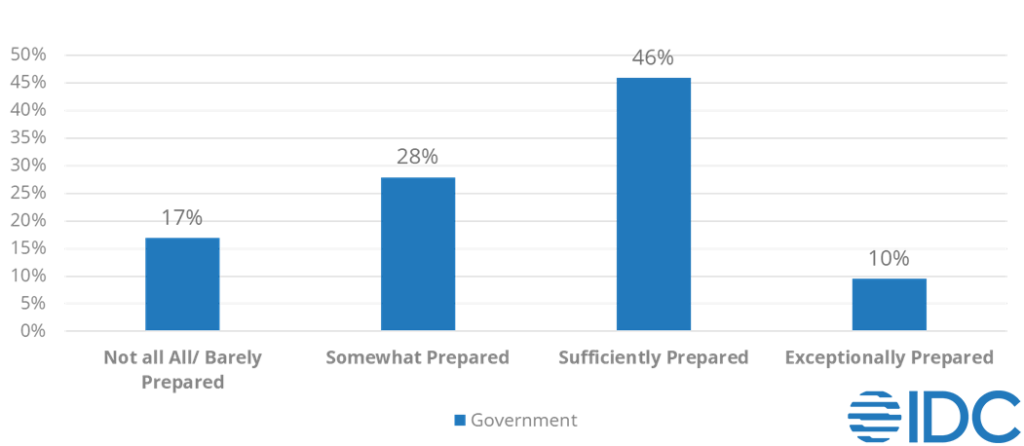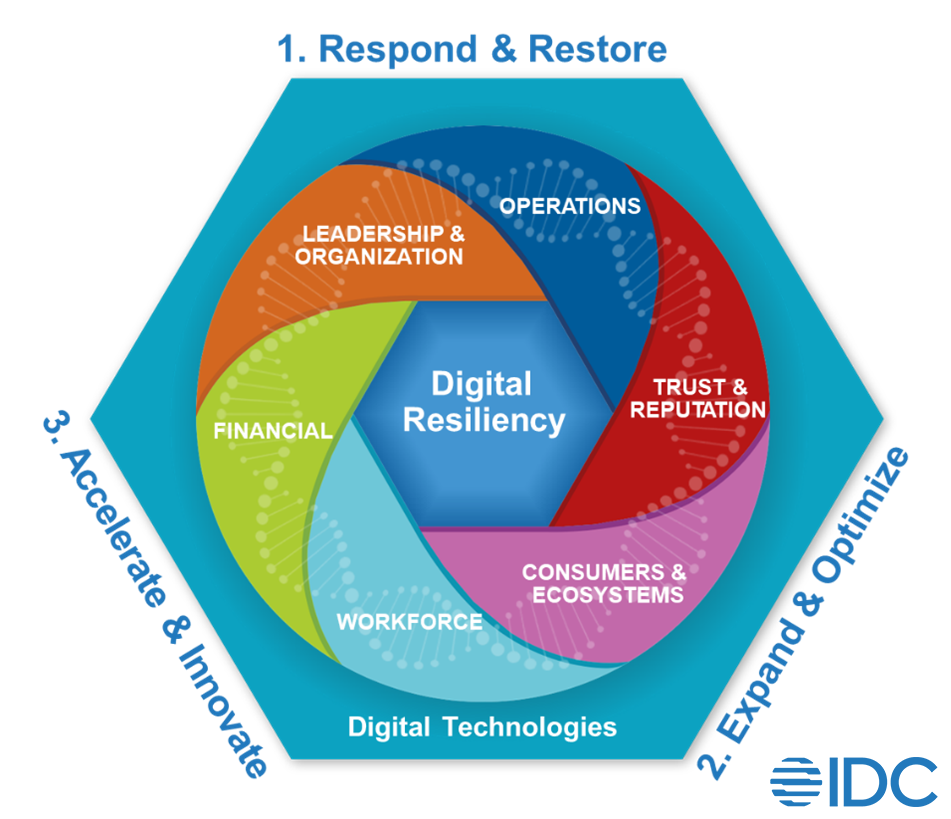Digital Resiliency Is A Key Aspect of Digital Transformation
The rise of smart cities and communities was founded in digital transformation. In fact, IDC’s view of a smart city is one that embraces technology for urban transformation to meet social, financial and environmental outcomes; a definition that takes an outcomes-based view of modernization and digitization in states, provinces, counties, cities and towns.
This includes a broad discussion of factors related to buying and implementing technologies, including looking at work culture, new processes, employee skills and resident needs and expectations. To be effective, technology has to take into account these factors, and many of these factors have been permanently altered due to the COVID-19 pandemic.
Recent events, not just from the COVID-19 pandemic, but also from the ongoing cyberattacks on governments and severe weather events that cause local emergencies, have shown that many regional and local governments are not fully prepared to respond to these events (Figure 1).
At the same time, large-scale disruptive events illustrate how important it is for government organizations to able to rapidly respond in order to keep essential services running as well as quickly pivot to offer new services. This agility, security and flexibility to respond depends on digital resilience. We further detail resiliency in the digital transformation of regional and local government in IDC’s new eBook, Building Digital Resiliency in Smart Cities and Communities.
Figure 1: Government Preparedness
Question: How prepared was your organization to respond to the COVID-19 pandemic? (Government Respondents Only)

Source: : IDC Future Enterprise Resiliency & Spending Survey, February 2021
Continued Disruption and Change Leads to a Proactive Stance on Digital Resilience
It is clear that we can expect continued volatility, change and disruption; ransomware and DDoS attacks will continue against regional and local governments and environmental events will continue and are becoming more frequent. Additionally, the rapid pace of information sharing and technology means that business and residents will have rapidly changing needs when it comes to customer service and experiences with government.
As a result of the COVID-19 pandemic, we have witnessed the rapid adoption of new technologies by residents, a change in opinion by government agencies about working from home, and new desires by communities for more digital government experiences. These will all drive changes in policies and regulations, from new permitting bylaws to new accessibility options, and result in changes that need to be adopted.
So, what do we mean by digital resilience and proactive stance on digital resilience?
Digital Resiliency is the ability of an organization to rapidly adapt to business disruptions by leveraging digital capabilities to not only restore business operations in a timely manner, but also capitalize on the changed conditions.
Digital resiliency is about acknowledging and sometimes modifying the interdependencies and risks associated with technologies embedded in almost every aspect of government. The key is that digital resiliency is not just defensive, as in disaster recovery or cybersecurity; digital resiliency is also proactive in that cities, counties, states and provinces use technology to improve services in response to changing circumstances and/ or disruptions.
Becoming More Digitally Resilient
IDC’s Digital Resiliency Framework identifies three stages of digital resiliency that show this progression from a reactive response to one that takes advantage of changed conditions:
- Respond and Restore: This phase emphasizes the safety and security of the workforce, disaster recovery of systems and meeting budgetary spending targets. Critical digital technologies that support this stage center around business continuity, crisis management and communications. This is not the time for deep analysis, planning, or investment, the onus is on action and action fast.
- Expand and Optimize: This phase emphasizes productivity, faster decision-making, community outreach, stabilizing supply chains and cost-reduction. There is some time to analyze, to plan, and cautiously, to invest. Existing technological capabilities are improved, expanded and optimized to respond to gaps in capabilities exposed by the disruption. Typical digital investments are modest, and involve improved reporting and intelligence, cloud migration, remote working, privacy and security, data optimization and the supply chain.
- Accelerate and Innovate: This phase incorporates digital resilience as a core tenet of the future to survive and thrive. Priorities include creating a learning organization, agile business operations, expanding supplier ecosystems, and planning for the next crisis. Typical investments are substantial e.g., AI automation, analytics, digital twins, cloud-native development.
These phases also apply across six organizational areas of resiliency – organizational, financial, operational, workforce, trust and reputation, and consumer and ecosystem resiliency. Each of these have their own outcomes and digital tools used to achieve these outcomes, depending on the phase of resiliency.
IDC’s Digital Resiliency Framework

Source: IDC, 2021
As an example of digital capabilities that might be considered in the Expand and Optimize phase for Workforce Resiliency, regional and local government may consider investments in:
- Low Code/No Code environments so non-IT staff can respond to constituent needs quickly
- Automation for scaling processes such as community communication and outreach
- Collaboration tools for hybrid workforce support
- Document management and content workflow tools to move to paperless government
- Cloud-based platforms for connected experiences
Guidance for Building Digital Resiliency in Smart Cities and Communities
Take a Proactive Stance on Digital Resilience: There are many ways to begin to build digital resiliency, but the first step is to look at it as beyond business continuity and disaster recovery. While of course BC/DR is foundational, resilience needs to extend to include agility, flexibility, and security postures across six organizational dimensions.
Use Cloud Platforms for Agility: Cloud can offer security enhancements and allow for agility to scale or downsize operations and get access to continuous improvements. Migrating legacy systems that have reached their end-of-life is an opportunity, but there are also new COTS cloud applications that could be implemented quickly to expand capabilities for constituents.
Design for Trust and Security: To continue to be viewed as a trusted source of information and services, governments need to design for trust. Trust occurs when community information is kept private and secure, websites offer clear instructions on processes and actions, data is searchable and published, governing activities are transparent, the public sees a response to its inputs, and accessibility and inclusion is embedded in all services.
Enable the Hybrid Workforce: A resilience workforce is one that can perform its core job functions regardless of location. As discussed above, tools should be in place to provide tools so work can continue even if offices are closed.
Manage Current Skill Environment: There is certainly a strain on government workforces and finding needed skills in analytics, application development, security skills and other high demand IT skills. That means that technology investment should include considerations for the required staff skills inhouse to keep systems up and running, as well as usability by non-IT staff.
In response to COVID-19, local and regional governments showed that they could be agile, responsive and innovative; organizations expanded operations to support the unique requirements of a pandemic – e.g. a remote workforce, digital services, more mobility and automation. We need to incorporate lessons learned from this experience and continue to move forward with plans for expanded services, digital transformation and resilience to future disruptions. To learn more about IDC’s Digital Resiliency framework and the tools and technologies that enable digital resiliency in smart cities and communities, watch the on-demand webinar, “Building Business and Digital Resiliency in Smart Cities“. Click the button below to register.




